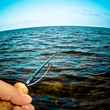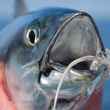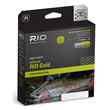When I head out in the field to test gear, whether it be a rod, reel, pack or something else, my usual goal is to embark with said piece of gear knowing relatively little about it. In other words, I like to avoid reading the marketing. Sure, I want to know what the product is and what it is supposed to do, but I don't want a bunch of advertising speak to predispose me to forming certain opinions about the product. A product's virtues, as well as flaws, stand out more when they're discovered organically.
Staying ignorant about the product you're off to mess around with is fairly difficult when it comes to rods, since little more than "medium fast action that's full of feel" is enough to bias you before you even cast a rod, but is fairly easy when it comes to reels given their complexity, the vast number of reels on the market, and the fact that reels -- unlike rods -- seem to lack a specific character. And so it was, or rather I was, relatively ignorant about many of the reels that I toted along to various warm, salty destinations this winter.
But what can you say about a reel? Sure, you can talk about materials, construction, drag type, arbor size, line pickup and so on. All of these things are important -- increasing in their importance as the size of the fish you're hunting increases -- but at the end of the day, what really matters is whether the reel holds up and stops fish. If it can do so with some modicum of grace, even better.
All of this is an unnecessarily exhaustive way of saying that a reel needs to give you something to say about it. Simply doing its job isn't enough. So, upon returning from my winter travels with a gaggle of reels (yes, I've decided that a group of reels should be termed a gaggle), all of which performed and performed well, I found myself with little to say about them.
Five paragraphs into this review, I'm finally getting to the point: it wasn't until I returned from the field and dug into marketing materials and specifications that I avoided before embarking that I realized two of the reels I had been fishing -- Sage's 2200 and 3200 series reels -- had given me something to say about them. And what I learned from those materials wasn't details about drag or construction or the pedigree of the fellow that designed the reels or what fish I was supposed to be hauling in with them. What I learned about these two reel series was their pricing, and that's when they became interesting.
Being completely clueless that these two reels represented the "budget" or "value" offerings in Sage's reel lineup, they were spooled up with the highest of expectations. And after reeling in bonefish, jack crevalle, permit and even tarpon, those expectations were solidly met.
What Works
The 2200 and 3200 series, both of which are based on Sage's very popular (and more expensive) 4200 series, handled whatever tasks were thrown at them. The 2210 I had spooled up and paired with a 9 weight battled several permit through long, feverish backing runs. The 3280 did its job on bonefish after bonefish without breaking a sweat. Whatever else was asked of them, they delivered.
What more is there to say? Oh, right, the pricing. As noted, these two series represent the value end of Sage's lineup, although you might -- as I did -- fail to notice when you're using them. The fully machined 3200 series ranges in price from $199 to $239, while the die-cast aluminum 2200 series can be had for as little as the hard-to-believe prices of $129 to $159. Honestly, pricing on both reels is wholly shocking given their performance and the name that's emblazoned on their side.
Both reels feature the increasingly popular pop-off frame for spool changes and the like, which is handy. If you're considering either for use as a spey reel, look at the more afforable 2200. The 2200 series offers a considerably larger spool volume than the 3200 making it more appropriate for handling spey lines.
What Doesn't
Well, nothing. At least not so far. That was sort of the point of this whole rambling, incoherent mess. I did find myself noticing that the finish on the 2200 series scuffs more easily than I'd have liked it to and -- while laboring under the delusion that I was fishing an expensive reel -- planned to make a note of it to Sage. Once I discovered that I was instead fishing a $159 reel, I realized I didn't care. I'm not one of those guys that babies their reels anyway. Dings and scrapes from stream side rocks and boat bottoms are the scars of a reel well used. They're not show pieces.
Final Word
Given my experience with these reels, I'd say with confidence that either would represent an excellent value to virtually any fisherman. They may, however, represent a particularly ideal value for those of you out there that spend most of your time fishing for trout with your five weight, but need a spey or saltwater reel that -- while you'll regrettably only use it a handful of times each year to chase steelhead, stripers, bonefish or what have you -- you want to be able to trust and use with confidence.
LEARN MORE ABOUT THE SAGE 3200 SERIES REEL (via Sage)
LEARN MORE ABOUT THE SAGE 2200 SERIES REEL (via Sage)































Comments
ginkthefly replied on Permalink
Had just decided against the 2210 as a steelhead reel, figuring it had to be a piece of junk for that price. Very glad to hear otherwise. Time for another look see.
JT replied on Permalink
The arbors look pretty darn similar based on that photo. There's really a significant difference?
If not, I'd rather go with the 3200.
Chad Shmukler replied on Permalink
The photo is deceiving, because the 3200 is leaning on top of the 2200 and was taken in close with a wide angle lens.
The 2200 has a 0.6 inch greater spool diameter and is rated for 200 yards of 30 pound backing. The 3200 with its smaller spool still gets rated for 200 yards, but not 30 pound.
Whatever the specs, I doubt you'd be able to use the 3200 series for spey. Maybe some switch applications, but not full sized spey rods.
chris wilkes replied on Permalink
The real difference is how they are manufactured. One is machined cast aluminum and one is machined bar stock aluminum. As a metal worker, I know first hand about the how the properties differ from cast metal to machined metal. Cast metal is porus, while machined metal is not. The machined pieces will be more durable in the long run. That being said, I just bought a 2280, and I cannot wait to take it out.
pod replied on Permalink
Well the one on the right sure looks more full. Both spooled with WF floating lines and the same amount of backing?
Chad Shmukler replied on Permalink
Both WF floating lines, but the 2210 (the one on the left) had about 30 yards more backing on it.
Richard E replied on Permalink
You wrote " If you're considering either for use as a spey reel, look at the more afforable 2200. The 2200 series offers a considerably larger arbor than the 3200 making it more appropriate for handling spey lines." I'm not sure how to interpret this observation. Often spool volume is a big deal to accommodate the large(r) sized spey lines. If the 2200 has a larger arbor, then it has less line capacity than a similarly sized 3200. What did you mean? Did you mean maybe that the same size 2200 has a larger diameter spool, or maybe offers more volume, than a similarly sized 3200?
Also, you wrote "I did find myself noticing that the finish on the 3200 series scuffs more easily than I'd have liked it to..." and "Once I discovered that I was instead fishing a $159 reel..." I believe the finish of the 2200 series is the finish that scuffs more easily than that on the 3200, and the price point you reference is for the 2200 reel. Is there perhaps a typo here, and you meant the 2200 reel?
Thanks
Chad Shmukler replied on Permalink
Both typos, Richard. Text updated to read as it should. Can't believe it took this long for anyone to notice the inconsistencies. Have a look and let me know if you have any other questions.
CPB replied on Permalink
I know you tested the 2800 on permit. Would you recommend it on bonefish too?
Pages